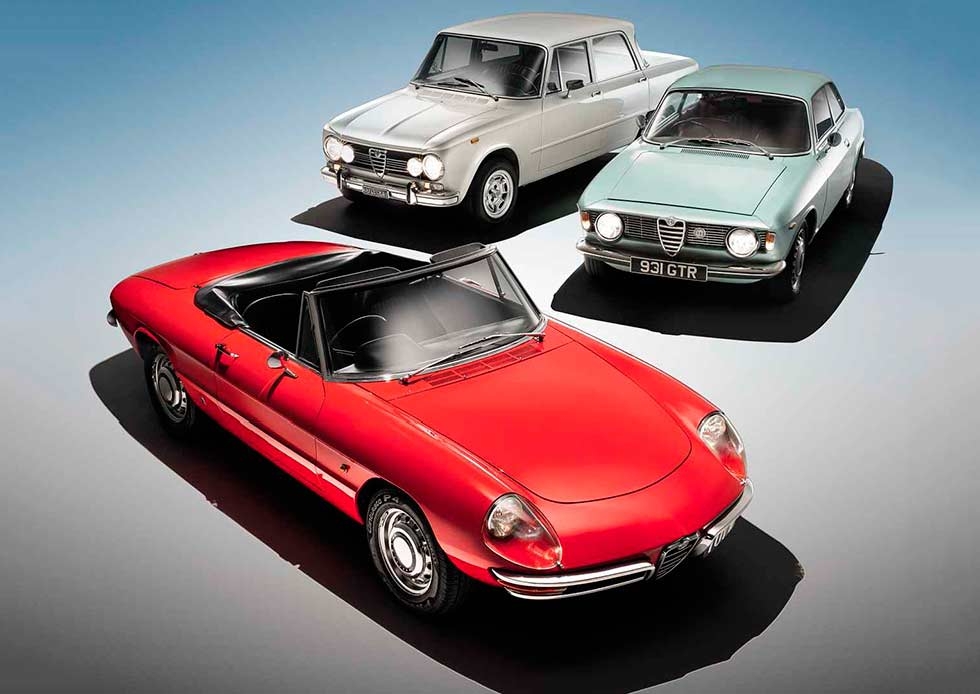
What’s so special Giulia Coupé examined. Iconic Alfas! Bumper triple-feature special: Giulia Coupé examined; across the Alps in a Berlina; secrets of The Graduate Alfa Spider. If any Alfa Romeo defines the appeal of the marque, it’s the Giulia GT coupé. John Simister explains. Photography Tim Andrew. Why the GT Coupé is an all-time great…
The 105-series defines all that’s best about Alfa Romeo. Octane explores the enduring appeal of the Coupé, saloon and Spider.
So, should everyone really buy an Alfa?
The common view, helped along by Jeremy Clarkson, is that all motoring journalists will have possessed an Alfa Romeo at some point. The occasional punchline is that said motoring journalists only like Alfas because they can hand them back to the manufacturers when they break them.
Well, we at Octane own our cars, they’re not borrowed from manufacturers, and sure enough most of us have indeed possessed Alfas, which on the whole have proven to be as reliable (or not) as any other classics. I’m afraid I let the side down here, though in my defence I did nearly buy a Giulia coupé once.
Fortunately we have a true Alfa Romeo disciple on Team Octane, and that’s art director Mark Sommer. He drives a 2005 Alfa GT as an everyday car and has owned all manner of other modern-ish Alfas – though never a true classic. As you may have gathered from recent Octane Cars contributions, Mark (known in the office as ‘Mk2’, to distinguish him from deputy editor Mark Dixon ‘Mk1’) recently treated himself to a 1969 Giulia saloon, bought and restored remotely via contacts in Milan.
When it came to collecting the finished article, what else could he do but embark on one of those once-in-a-lifetime experiences of flying out to pick up the car and drive it home – in this case over 1000 miles via the Alps. Of course, this is magazine feature gold, and the two Marks travelled together to enable Mk1 to photograph Mk2’s epic journey.
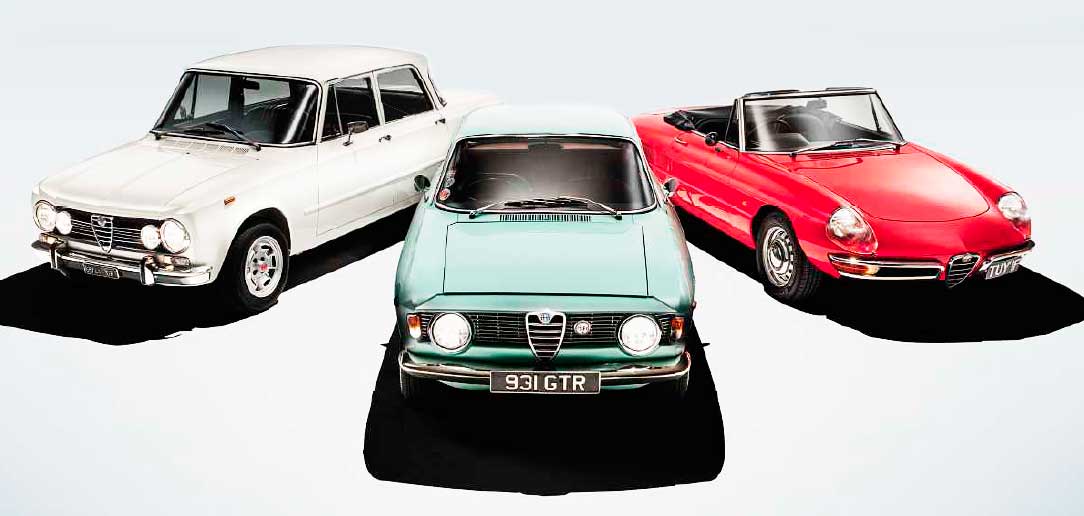
1964 Alfa Romeo Giulia Sprint GT 1600 vs. 1969 Alfa Romeo Giulia 1300 Berlina and Alfa Spider
Along the way they became ever more immersed in the charms (and troubles) of Alfa Romeo, and emerged determined to delve deeper. Hence this issue, with a triple-treat of Alfas: Mark’s Giulia saloon; the story of the Spiders used in The Graduate; and, to tie it all together, a piece by John Simister on the Giulia coupé that explains how it is that the sum of relatively normal parts can result in something so much better than it should be.
As for me, I’m once again left wondering why, of the 40-odd cars I’ve owned, none has been an Alfa Romeo.
{CONTENTPOLL [“id”: 112]}
Giulia Coupé goes under the studio spotlight 1964 Alfa Romeo Giulia Sprint GT 1600
If any Alfa Romeo defines the appeal of the marque, it’s the Giulia GT coupé. John Simister explains. Photography Tim Andrew.
Are you a devotee of Masterchef? I am no cookery buff but I find the programme fascinating. It’s not the ingredients themselves, although they are often interesting enough, but the way they are blended or juxtaposed to complement each other in unexpected ways. The result can be a dish tastier and more exciting than you would ever expect.
An Alfa Romeo Giulia Sprint GT is like that. Here, the ingredients themselves are quite highly refined, if conventional, but taken together they work a magic beyond the individual total of their contributions. So we have a four-cylinder engine (albeit one with block and head made from aluminium), twin overhead camshafts, and a cast aluminium sump with cooling fins. We have a regular gearbox driving a live back axle, but the gearbox has five forward ratios – very exotic at the time – and the back axle is very precisely located.
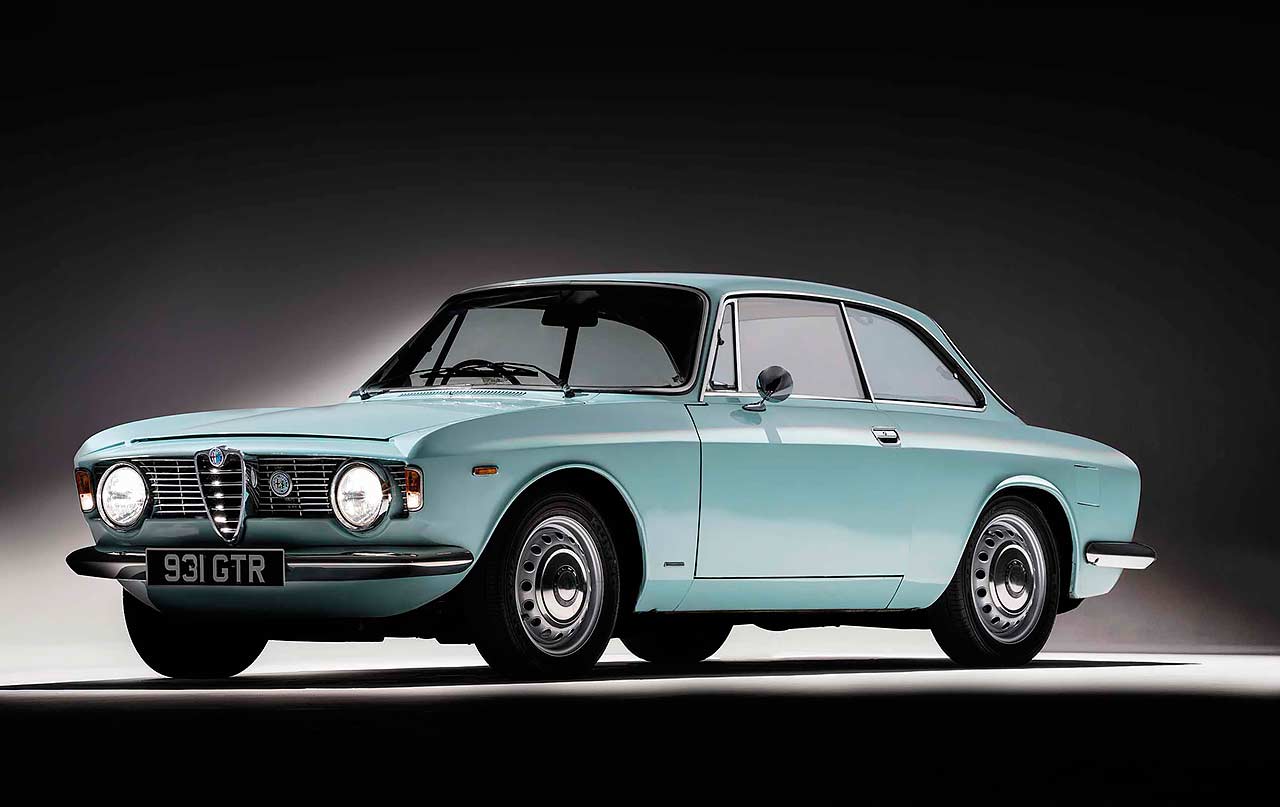
1964 Alfa Romeo Giulia Sprint GT 1600
It continues. All four brakes are discs. Front suspension is by double wishbones, but the upper wishbone’s forward arm is adjustable for length and contains an additional voided bush for longitudinal compliance, to improve comfort without compromising geometry. All the front suspension’s pivot bushes are polyurethane, with coaxial inserts in solid nylon, bulged to reduce lateral movement. Every little thing to do with the way the Alfa moves has been optimised, so everything works in harmony.
I had driven a couple of slightly tired Giulia GTs of various denominations in the 1980s and 1990s, and while I could see why people liked them – the look and the sound had much to do with it – I couldn’t really see why they got so fired up. Then, as 1999 turned to 2000 and I gathered together several cars with 2000 in their names for a topical group test, I got the point. One of the cars was a white 2000 GTV, owned for many years by a stalwart and fastidious member of the Alfa Romeo Owners’ Club.
It was a revelation. The torquey 131bhp engine had an eager, snap-crackle throttle response and a discreet bark to its exhaust. In the corners it had a beautiful balance and an easy confidence, its ability to flow and to suck the driver into its actions making up for the lack of ultimate precision. It talked to me with little nudges and fidgets as it moved, always communicating, never irritating. It bared its soul, driver and car in tune with each other. So what if the gearlever’s movements were as much vertical as horizontal, if the pedals were floor-hinged and vintagefeeling?
It was the effect of moving them that mattered. Later left-hand-drive cars got conventional pedals, incidentally, but never the right-handers. It really doesn’t matter at all, any more than it does in an air-cooled 911. And then there were the visuals. From the driving seat, deeply cowled round dials, although this particular Italian stereotype didn’t actually emerge until a few years into production. Under the bonnet, an engine as sculpture. And from the outside, the shape of a particularly covetable-looking coupé.
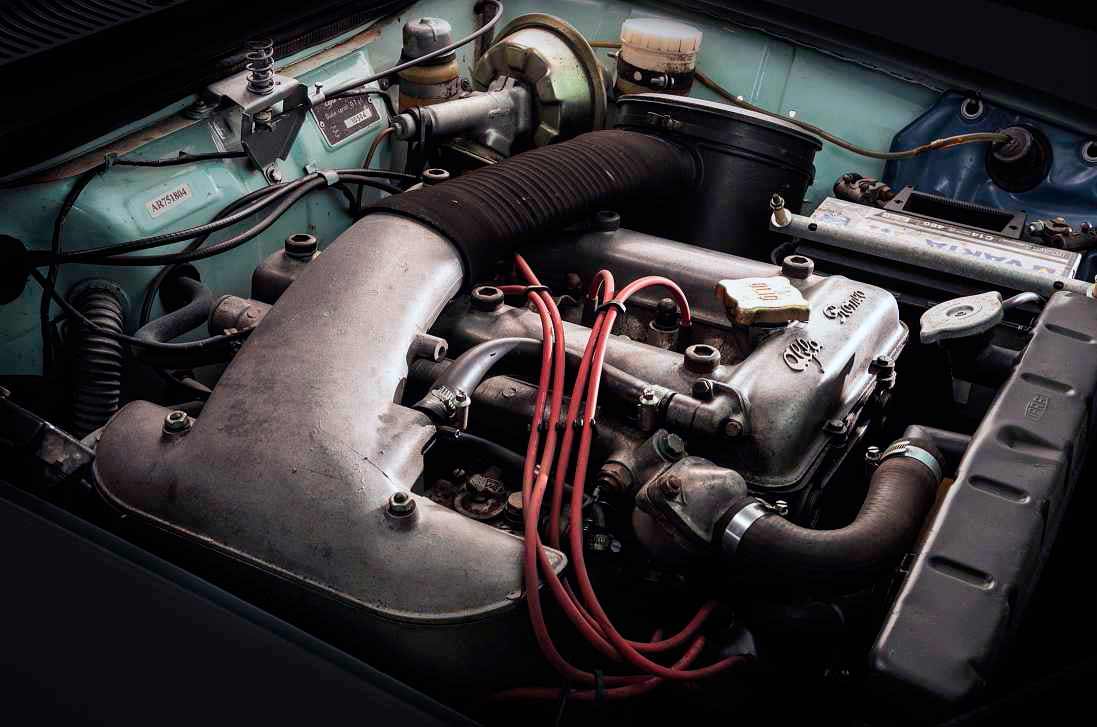
1964 Alfa-Romeo Giulia Sprint GT 1600 engine
Bertone was Alfa Romeo’s main shaper of post-war coupé bodies. From Nuccio Bertone’s Turin design house had come the Giulietta Sprint, for example; and the Giulia Sprint GT’s muscular shoulders, convex waistline and slightly drooping haunches were a link to its predecessor. But by the time the Giulia GT was gestating, Bertone had on his staff a young, forward-looking designer of independent spirit, one Giorgetto Giugiaro.
He was only 21 years old when he shaped the Giulia, and was juggling his creative outpourings with the need to fulfil his national service obligations. This made for challenging logistics, but somehow he managed to complete the clay scale model and drive his Renault Dauphine to the Bertone studio with it on his lap, to keep it from being shaken apart by bumps. A few bits had to be glued back on, including the bumpers, but both Bertone and Alfa Romeo loved the clean-looking coupé with its mix of curves and crisp edges.
The GT entered production in late 1963, looking almost exactly as Giugiaro had intended. But it was more expensive than the 101-series car it was meant to replace, now also confusingly called Giulia Sprint following an increase in engine size from 1290cc to the 1570cc of the new Giulia Sprint GT, and sales were slow to build. So, in a move highly unusual in the motor industry, Alfa Romeo put the 101-series Sprint back into production, keeping company with the Giulia Spider and the ultra-curvaceous Sprint Speciale. The last of these continued up to 1966.
It was four years earlier that the first 105-series cars – the series to which the Giulia Sprint GT and its variously named descendants belonged – had entered production. The series began with the square-cut Giulia saloon, a 1969 example of which is featured on pages 72-78 which used the same underpinnings as the GT apart from a longer wheelbase (98.9in instead of 92.6in). Its 1.6-litre engine made 92bhp via a single twin-choke carburettor, which left room for an easy upgrade for the GT whose 106bhp was gained with the help of a pair of Weber 40DCOEs.
As with every post-war Alfa up to that time, the 105 series was developed under the engineering eye of Orazio Satta Puliga. He had masterminded the 1900 range that brought Alfa into the (relatively) mass-production mainstream as part of its post-war reconstruction, then oversaw Giuliettas, Giulias, Alfettas and the Montreal, as well as the 158 and 159 Grand Prix cars. He had at his disposal a rich supply of engineers steeped in aviation before and during the war, who now needed a new outlet for their skills.
One result of this was the Giulia saloon’s astonishingly slippery aerodynamics, with a drag coefficient of 0.34 when most saloons – especially rectilinear ones – were well over 0.40. The shape of the tail’s cut-off is the key; the seemingly sleeker coupé flows more turbulently through the air, recording a Cd of 0.42.
So, at launch, the only difference in designation between the new car and its life-extended predecessor were the letters ‘GT’. And it differed little mechanically, for the previous model had a five-speed gearbox and a coil-sprung rear axle located by lower radius arms and an upper T-shaped link, and Alfa Romeo continued with a steering box for the new car rather than a rack.
Instead, the underskin devil was in the detail. And with those GT letters came Giugiaro’s much more modern look, albeit with a curiously fussy face. That fussiness was the result of what came to be called the ‘stepfront’ design, once it had been superseded at a significant facelift in 1967, and it made the bonnet look as though it didn’t fit properly. Now, of course, that step is a vital part of early Sprint GT iconography.
Inside, the dashboard was a simple transverse slab slightly divergent around the instruments, at least until 1967. That, clearly, is a milestone year, but plenty happened to the Giulia Sprint GT before then. First it spawned a short-lived GTC convertible, converted by Touring. Then it became the GT Veloce, or GTV, in 1966, with an extra 3bhp and slightly more torque thanks to a revised cylinder head with a narrower angle between the valves, and a larger diameter for the exhaust valves. A 1300 GT Junior joined the range, too. Meanwhile, the GTA racing version was dominating the European Touring Car Championship.
Ah yes, the GTA, the Holy Grail of Giulias. Gran Turismo Alleggerita, or ‘lighter’, by a massive 200kg. Thin aluminium skin panels were riveted to thinner steel inner panels, the side windows were Perspex, trim was lighter and simpler, many parts were drilled, wheels were magnesium, and so on. The engine gained a new head with bigger valves, two spark plugs per cylinder and 45DCOE Webers on the side. Autodelta, Alfa’s racing arm and creator of the GTA, claimed just 115bhp for the stradale road version, but the reality was surely more. Andrea de Adamich duly claimed the 1966 ETCC drivers’ title, Alfa Romeo the manufacturers’. More success followed with a 1300 GTA, and wide-arched GTAm versions of both.
Now, 1967. That’s when the nose lost its ‘step’ and gained an extra pair of headlamps, the rear wheelarch openings cut higher into the body and the dashboard got the first interpretation of the cowled-dial look. All this came together for the 1750 GTV, but in typical Alfa fashion aspects of the old designs continued for a while – so a 1968 1300 GT Junior, for example, had the old nose and dashboard but the new rear arches.
Alfa Romeo’s Giulia GT family was settling down nicely as the most desirable, most ‘proper’ of compact sporting coupés. Its obvious Italian rival, the Lancia Fulvia Coupé, couldn’t match the Alfa’s increased engine capacity and musclepower. Germany’s BMW 2002 wasn’t quite a coupé. Britain’s MGB GT and Triumph GT6 just weren’t sophisticated enough, and the Alfa’s arch-rival on track, the Lotus Cortina, was based on a repmobile.
There was a fine new factory at Arese, outside Milan, but within its louvred concrete walls the GTs were built largely by hand. Cost-cutting was not part of the philosophy, and anything that emerged through Arese’s doors couldn’t help being infused with raciness. Even Alfa’s delivery vans and 4x4s had twin-cam engines.
And it turned out that the 1779cc, 122bhp 1750 GTV was more than just a visual facelift with intriguing openplan seats in whose backrests a gap appeared as you wound up the headrests. The dynamics were sharpened, too, with wheel size reduced from 15in to 14in to accommodate wider tyres, altered geometry to lower the roll centre and thus reduce the loading on the outside wheels, and a rear anti-roll bar added to compensate for the increased roll moment and reduce understeer.
In 1969 the GT Junior finally lost its step front but retained its two headlamps. In 1971 the 2000 GTV replaced a Mk2 version of the 1750 GTV, with 132bhp from its 1962cc to make it the most potent of production Giulia GTs – not that anyone was calling it Giulia any more. The Junior duly acquired a 1600 derivative, and thus they continued until the range faded out in 1976, having run alongside the new Alfetta GT since 1974. Alfa Romeo was never very decisive in its model changeovers.
Four decades on, we all still love the Giulia Sprint GT and its descendants. There are usually plenty for sale, some of them up-engined modifications of what were small-capacity models, but inevitably the market favours originality. Achieving that with the bodywork is quite a feat, given the breed’s propensity for rust, but South African-assembled cars can be a good-value route to a sound shell if you don’t mind a dilution of the Milanese dimension. Otherwise it’s a question of restoration, or finding a car that has been restored properly. The shape and fit of the subtly convex sills is a pointer, but it pays to examine every square centimetre of steel.
As for which will give the most ownership joy, I can comment only on some of those I have driven. Two were very early examples from 1964, one of them beautifully restored and which I almost bought. That it had a later 1750 engine worried me not at all, and livened it up considerably, but after I decided not to buy the seller decided to fit the correct 1600 and upped the price. It sold almost instantly.
Its soft, flowing responses were a contrast to the rorty tautness of a 1976 GT Junior 1600, uprated to 2.0 litres, lowered, stiffened, fitted with fibreglass doors and given a faux-GTA look with its mesh grille and alloy wheels. Were it not for the door gaps I might have been tempted, because it was a highly entertaining drive.
Then there was an early 1750 GTV, a bit tired and the victim of a cheap 1990s restoration. It had potential but needed more love than I could give. And, fabulously, there was a GTA Stradale restored by specialist Alfaholics, its engine enhanced with deeper-breathing camshafts. I could feel the lightness, the way the steering’s response had the keenness of a good rack system. It was that beautiful 1964 GT brought into sharp focus, shorn of inertia and played on fast-forward.
But the car that did it all, with pace, poise, sharpness and style, was that white 2000 GTV I drove in 2000. Perfect ingredients, perfectly cooked. My compliments to the chef, and please may I have another helping?
THANKS TO Stuart Taylor of the Alfa Romeo Owners’ Club UK, and owners Terry Richardson (GT) and Paul Clark (Spider).
TECHNICAL DATA FILE SPECIFICATIONS 1964 Alfa Romeo Giulia Sprint GT 1600
Engine 1570cc four-cylinder, DOHC, two Weber DCOE 40 carburettors
Power 122bhp @ 6000rpm / DIN
Torque 103lb ft @ 3000rpm / DIN
Transmission Five-speed manual, rear-wheel drive
Steering Worm and sector
Suspension
Front: double wishbones, coil springs, telescopic dampers, anti-roll bar.
Rear: live axle, trailing arms, coil springs, telescopic dampers
Brakes Discs
Weight 999kg
Performance
Top speed 112mph
0-60mph 10.6sec
THE OTHER 105-SERIES COUPÉ
Less elegant than Giugiaro’s, but the Zagato is rarer
You see them sometimes at classic-car gatherings: neat, unadorned coupés with something of the Alfasud Sprint about them in the truncated tail and the upward flip of the rear side windows. But here the four headlights are under a Plexiglass cover, and both the Alfa scudetta and the ovoid dashboard are ultra-minimalist.

Alfa Romeo GT 1300 Junior Z (105) 1969-1972 design by Zagato
Meet the Alfa Romeo GT Junior Z, launched in 1969 (long before that Alfasud) as a 1300, growing to a 1600 in 1972. That’s Z for Zagato, with a whiff of the racing TZ in its aura if not its avoirdupois. The Junior Z was built on the shorter wheelbase (88.7in) of the 105-series Spider (the one launched as the Duetto), and as a cosy two-seater it made an exotic alternative to the regular Giuilia Sprint series. Only 1510 Junior Zs were made, the last in 1975.
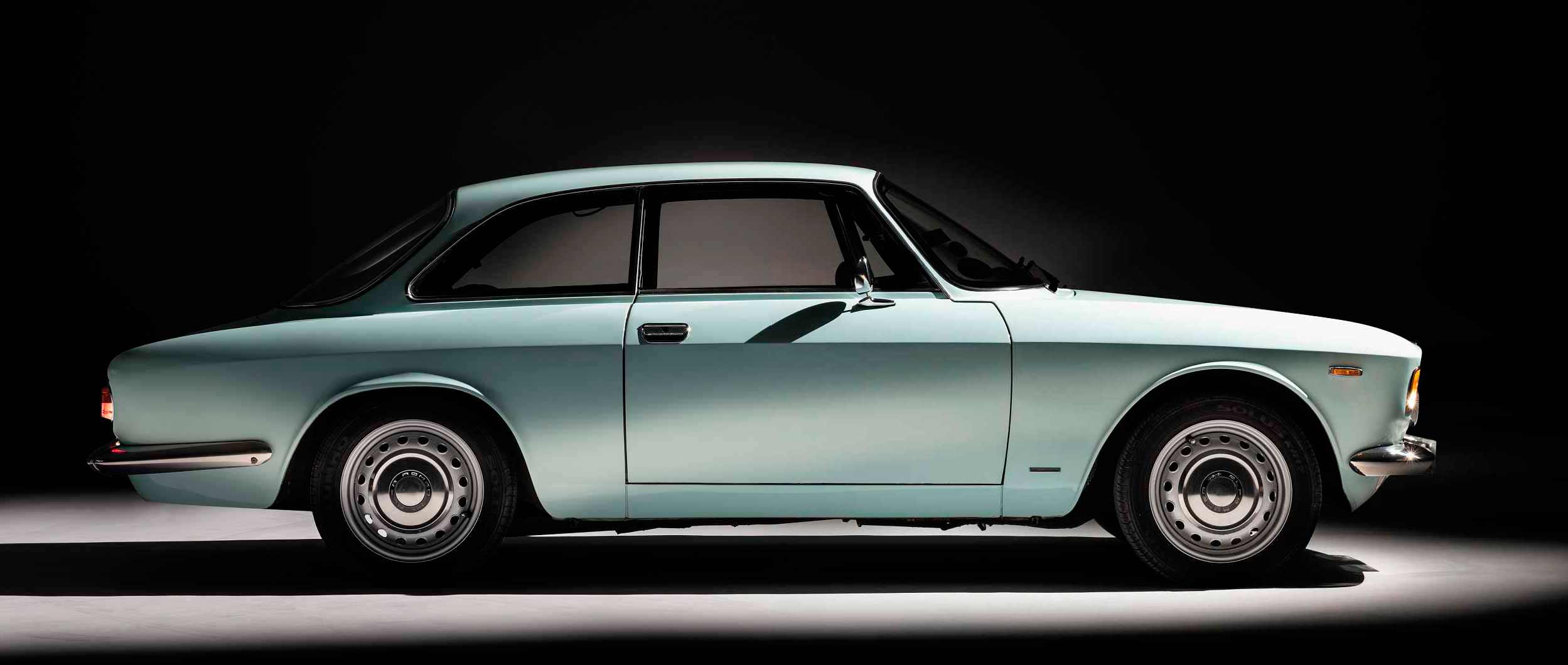
Above Simple lines, perfect proportions, that slight droop to the tail: early proof that Giorgetto Giugiaro knew what he was doing.
‘Both Bertone and Alfa Romeo loved the clean-looking coupé with its mix of curves and crisp edges’
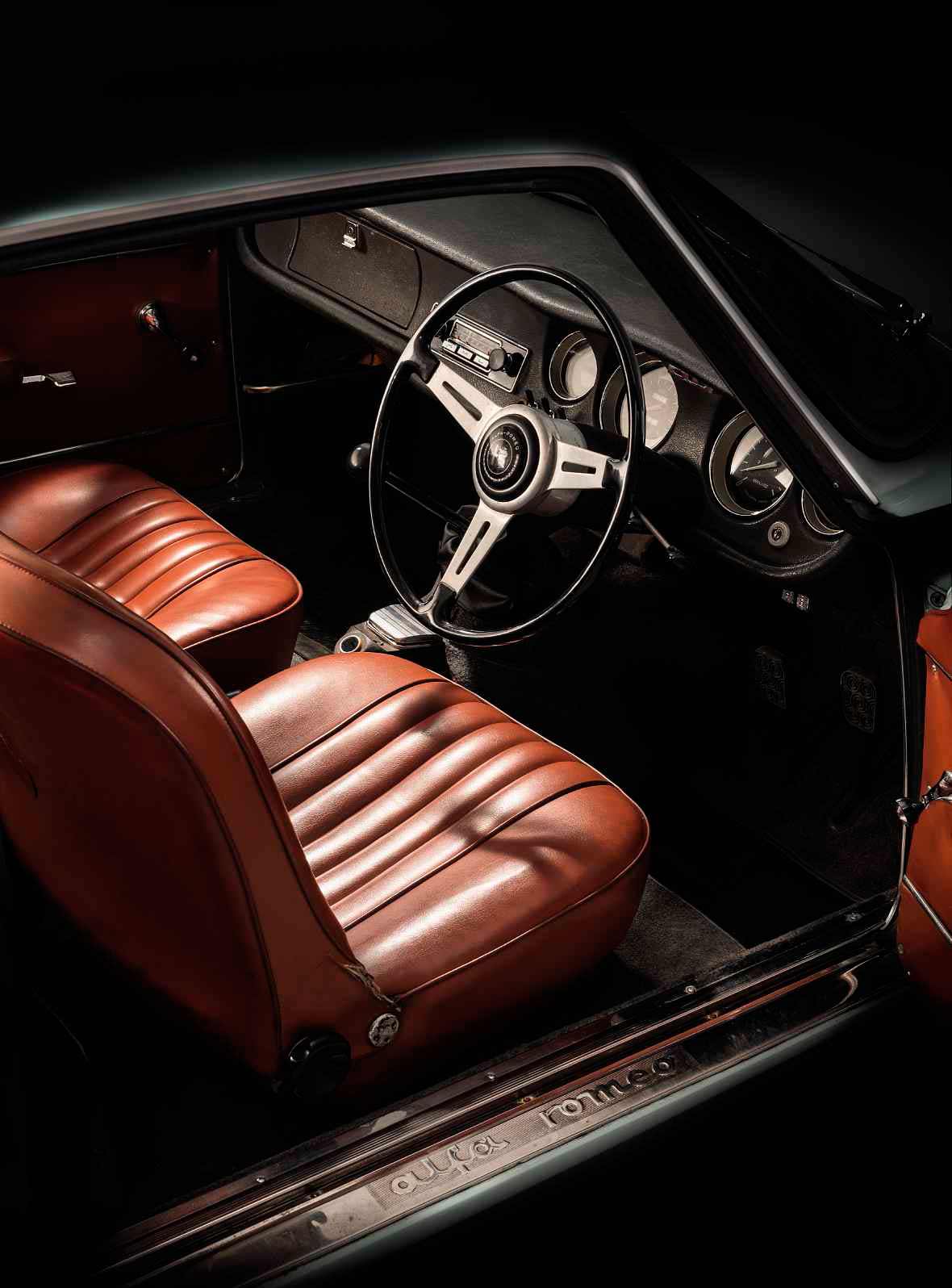
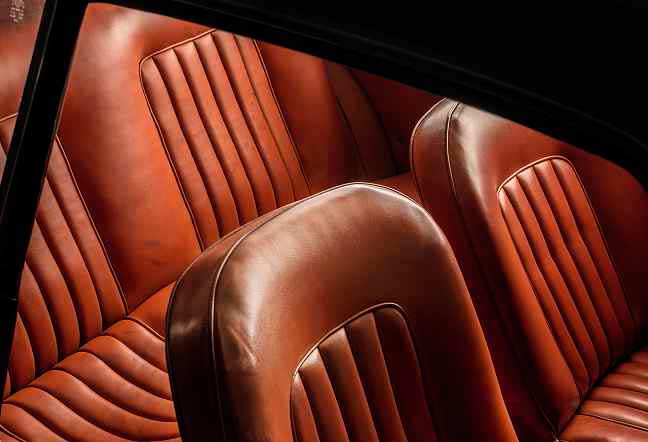
Above and far left Tan vinyl seats look classic and comfortable; simple dashboard is a masterpiece, replaced by complication in later cars.
‘Four decades on, we all still love the Giulia Sprint GT and its descendants’
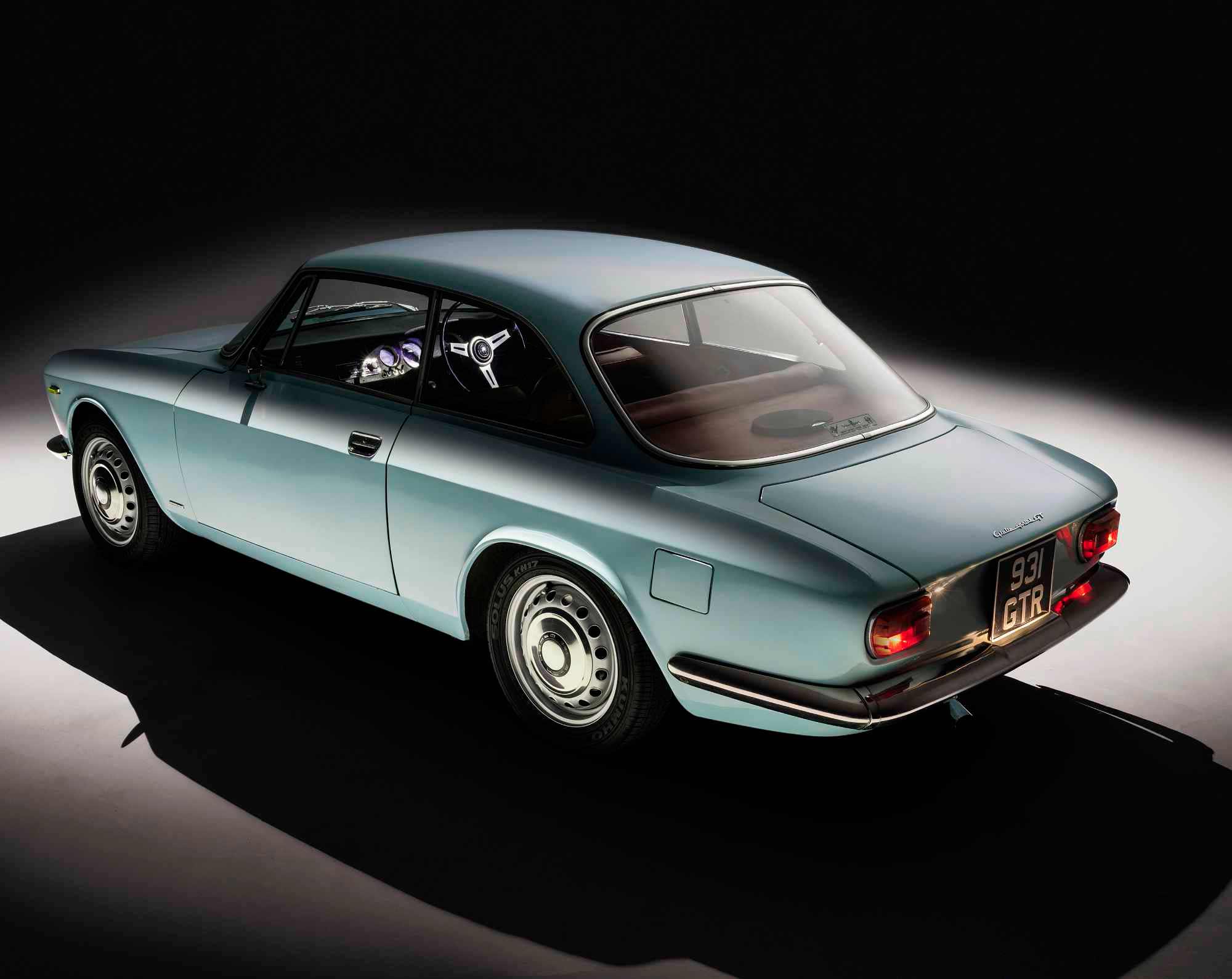
Left Compact, lightweight, blessed with thorough engineering and relatively plentiful, the Giulia Coupé is a must even for serious collectors.
1969 Alfa Romeo Giulia 1300 Berlina
The Alternative Mille Miglia Giulia Saloon Road Trip. Octane’s art director bravely bought an Alfa Romeo Giulia saloon – in Italy. Driving it 1000 miles home had its drama Words Mark Sommer. Photography Mark Dixon.
It’s fair to say I’ve been dreaming about this trip for a long time. Planning the route – Milan, Turin, some mountains, northward through France to the cross- Channel ferry – not to mention picturing, in my mind’s eye, that moment when the keys to a 1969 Alfa Giulia saloon are dropped into my hand. The keys to my Alfa Giulia saloon.
If you’ve been reading my Octane Cars reports you’ll know I’ve been anticipating this moment – counting down the days! – for more than a year. Just couldn’t wait. But there’s nervousness to deal with too. What if I don’t like the car, or the way it drives? Will it live up to my expectations or will I be disappointed by it? You see, I’d never even driven a Giulia saloon before. Looked at a few at shows, done a little window-shopping in the UK, but this was going to be my first time behind the wheel. And I’d have 1000 miles to get used to it before it even set a tyre on a British road.
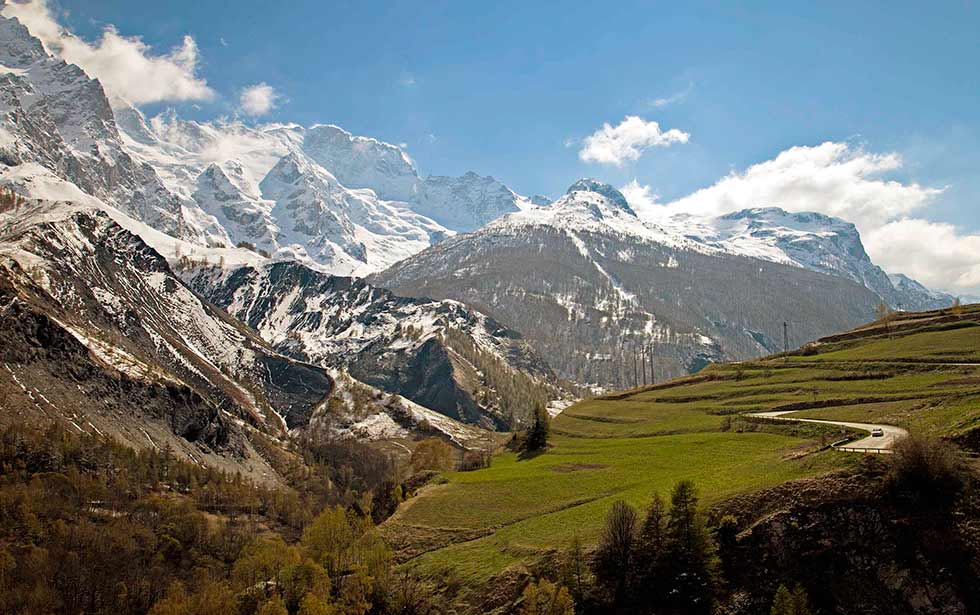
Finally I see the Giulia in its finished state. I’d flown over to Milan a few months back to check on progress in the bodyshop and hand over a bunch of euros. I got to poke around the workshop, prod the car, sit in it, play with the controls – but that’s as far as it went. Seeing it again, the dream made real, it’s prettier than I remember, especially now it’s had its beautiful Mille Miglia wheels refurbished. My wingman, Octane colleague and photographer (and possibly my mechanic too) on this trip is Mark Dixon. He gives me a nod of approval. ‘The car looks great!’ He’s not wrong.
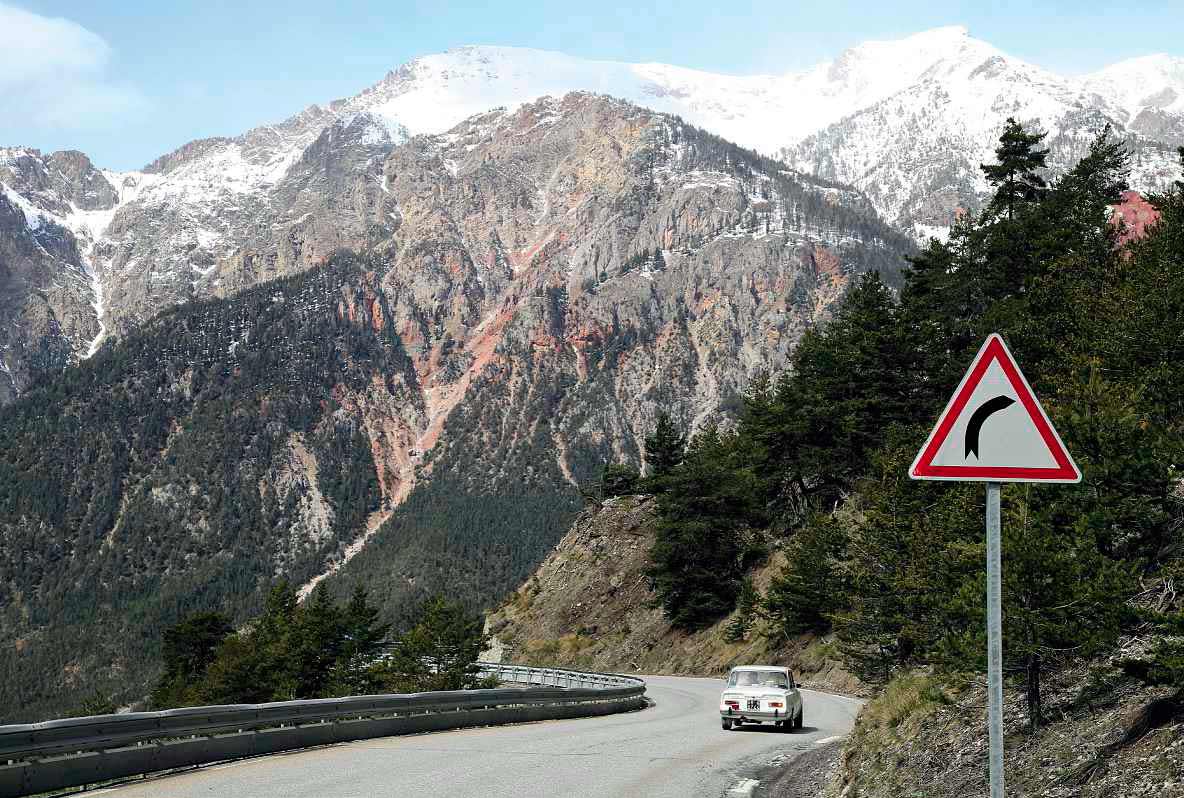
If you recall the Octane Cars reports, you’ll remember that our man in Italy, Massimo Delbò, found the Giulia and oversaw its bare-metal respray. I used the same bodyshop that had worked on several of his cars. I’d been in touch, ever-more apprehensive as the date approached, and he had advised me that the Alfa had broken down the day before we arrive, blaming a faulty dynamo. But no worries. It’s since been rebuilt and seemed fine when tested this morning.
Now comes that moment. The keys are dropped into my hands. The car is mine. I pause and contemplate what’s to follow. We’re fresh from an early-morning flight from the UK, so the plan is to drive the 60 miles or so to Massimo’s house in Dorno and stay overnight, then start our adventure the next morning, heading for the border and crossing over the French Alps to arrive in Calais after three days of driving. Plenty of time to enjoy the Alfa. Plenty of time to sort things out if we have any problems en route.
After its last polish by the bodyshop, the Alfa is out front, gleaming in the Italian sunshine. Time for a little inspection. The paintwork is pristine, those wheels really set the car off, and the hard-to-find replacement weather strips around the side windows look fantastic: much tidier than the originals, but perfectly patinated and therefore not too new-looking.
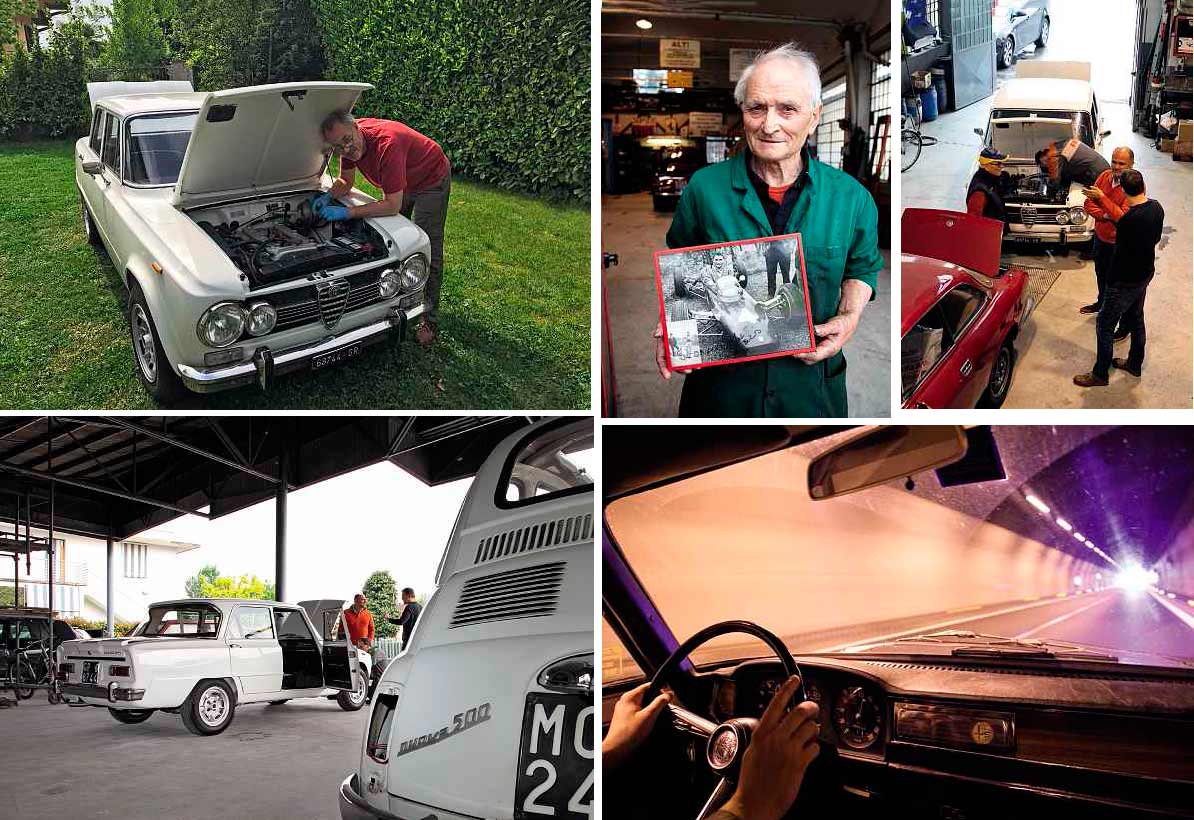
Then comes my chance, at last, to get in and start the engine. I click open the door, insert myself into that spare yet forgiving seat, place a hand on the wheel, and turn the key. It takes a few seconds before the 1300cc twin-cam comes to life and idles sluggishly. I guess that’s only fair; it’s been sitting here for more than a year while the bodywork was being attended to.
Time to enjoy that well-oiled yet well-defined gearshift, get used to the floor-hinged pedals and head west from Piadena and onto the Autostrada towards Dorno. It’s a drive of an hour or so, long enough that I can become accustomed to how the car drives, get used to its foibles, and re-educate myself in the manners of a classic: this is the oldest car I’ve ever owned.
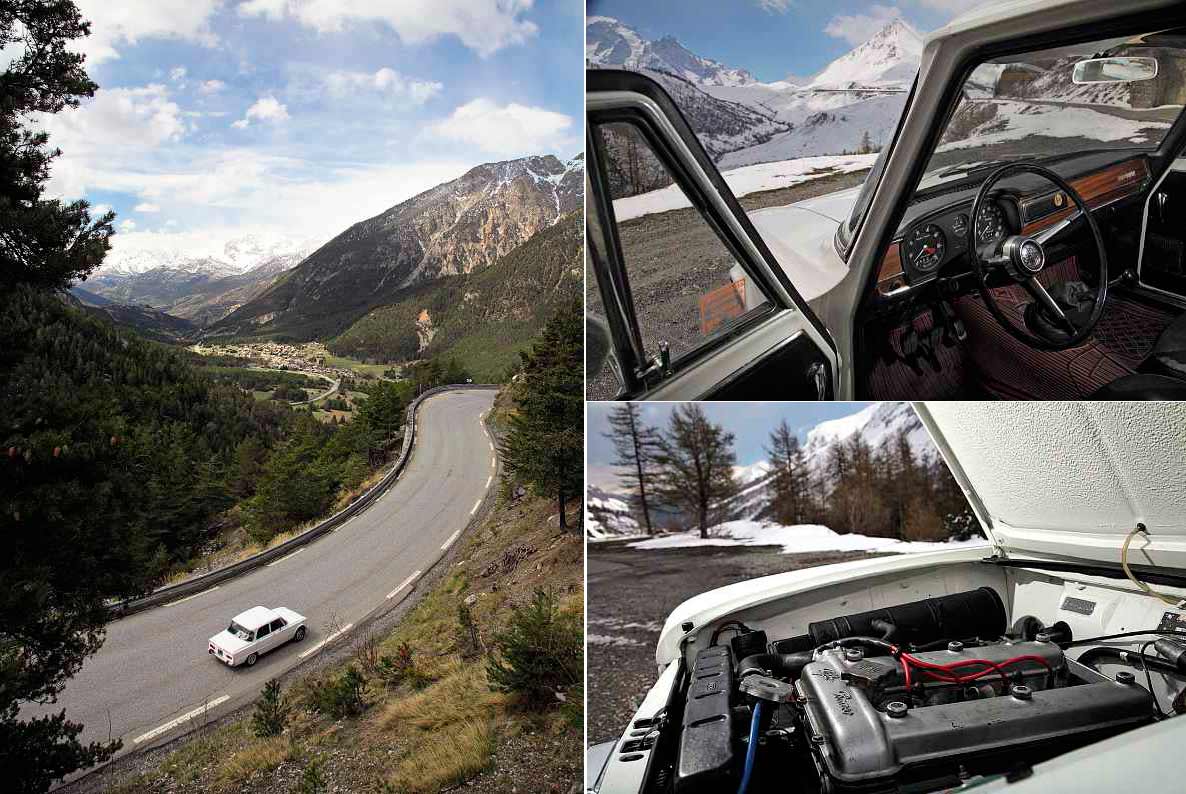
To be honest, it feels a little down on power, as though it’s running on three cylinders, but as the miles pass the engine begins to free up, and I’m surprised and delighted by the slickness of the gearchange, even though, as with many 105s, the synchromesh on second is a little worn.
Still, we’re well able to keep up with traffic on the Autostrada, and the fifth gear makes the car a capable cruiser, happily sitting at 120km/h. I guess we can thank the car’s advanced 0.34Cd aerodynamics for that.
As we approach Massimo’s village I notice the indicators are running slower; then they fail completely. Not a good sign with such a long way to go tomorrow. We pull up at the gates to Massimo’s home, I switch the engine off and then, when I try to restart… nothing. The battery is evidently flat. It seems the electrical fault that had plagued it during the week has returned, and it’s getting dark outside. No choice but to leave the car overnight and try to figure something out in the morning.
It dawns on Italy’s Independence Day, a public holiday. If we can’t fix the car ourselves, we’ll have to wait another 24 hours because every garage will be shut. While Dixon wields a voltmeter and confirms that the dynamo isn’t working, Massimo and I enjoy the sunshine and call his mechanic in the next village. He can help us tomorrow.
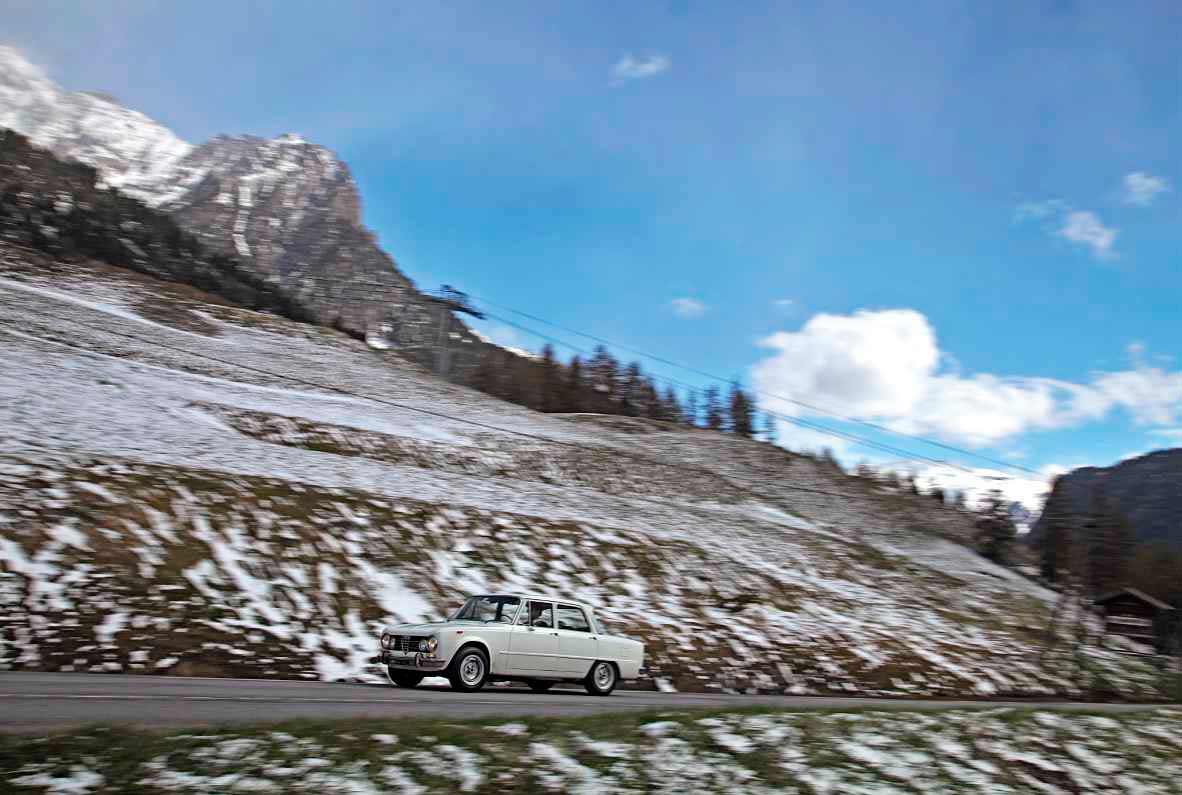
Thankfully the car has broken down here rather than halfway into the Alps…
When the sun comes up again, we jump-start the Giulia and head for the garage, where we’re met by Dino and his son Alessandro. Dino has prepared many cars for events such as the Mille Miglia and Tour Auto, so the Alfa is in safe hands. Massimo’s own 1300 GT Junior is also here, having work done. While Alessandro fits a replacement dynamo, Dino shows us photographs of the many cars from his past, including a framed picture of him sitting in a single-seat De Tomaso from his racing days.
Later, as we motor along happily, our luck turns with the weather: it’s raining, just short of Turin, as we discover that the dynamo still isn’t charging the battery. This isn’t how I’d pictured our road trip. Where are the blue skies, clean mountain air and Matt Monro? We turn off lights and wipers, drive sedately back to Dorno, and wait (and wait…) for Alessandro to check the system again.

Turns out the dynamo is being burnt out by a faulty control box – and he doesn’t have one in stock. Eventually, a suitable unit is tracked down in a town some distance away, which the redoubtable Dino sets off to retrieve.
What’s more, Alessandro has found a new/old-stock armature in his store room to rebuild the dynamo – result! It’s dark (again) as we head for our motel for yet another night. Feels more like Groundhog Day than La Dolce Vita. Come the morning, the sun is streaming through the curtains. I’ve already postponed the ferry, but still we have only two days to cover more than 1000 miles home. I take the lack of rain as a good sign: who’d have wanted to drive through the Alps in a rainstorm anyway? We head via Turin again, the aim being to get as far into France as possible. We stop at the same service station where we’d aborted our mission yesterday. Mark takes out his voltage reader and clips it across the battery terminals. ‘It’s charging!’ he says. Our adventure can finally begin.
I get back into the car and thumb for a seatbelt that isn’t there: so many things I have to get used to. I reach for the floor to release the handbrake too, before remembering the umbrella-style lever under the dashboard. The floor-mounted pedals take some getting used to, but all of this is easily overcome and gives the car the kind of character I was hungry for. It makes it more involving to drive.
We’re into a groove now, the Alfa flowing steadily along, impressing with its stability and its verve through corners, the engine gutsy and torquey rather than a blazing powerhouse, but it revs easily and has an encouraging voice. The scenery begins to turn distinctively Alpine, the hills becoming mountains as we leave the Autostrada. My confidence grows with every mile: hopefully we have left our electrical problems behind us. Finally it’s time to revel in the stunning scenery I’d had in my mind’s eye for so long. The raspy 1300 twin-cam is on song as we speed through the foothills of the Alps, heading for a lunch halt. Time also to re-plan our route, as the old one has long since been torn up.
We head up the La Grave pass (in the cult skiing destination of La Meije) towards its summit, the little 1300 struggling manfully with two heavy-ish blokes, luggage and camera gear. Yet there’s no stopping the Alfa, and we climb ever higher into the Alps. You have to rev that twin-cam but, with such an enthusiastic reaction to the throttle, that’s never a hardship.
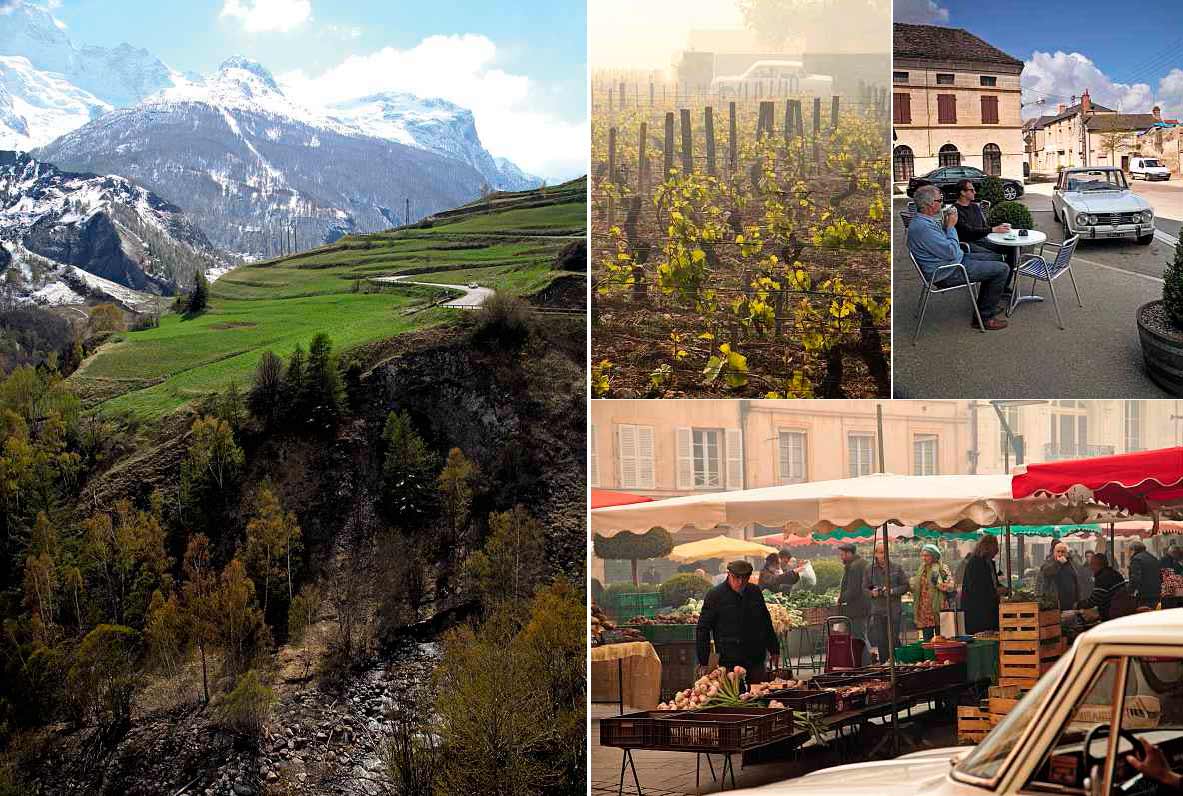
1969 Alfa Romeo Giulia 1300 Berlina
A flurry of snow greets us at the top, but nothing can dampen my mood now. Instead we revel in the surreality of the spring weather while we stand outside the car, admiring the view, the sun peeking through snowflakes, which fall from an azure sky. It feels like a scene from a film, and not Groundhog Day this time. We’re rendered speechless, caught in the moment, until Mark turns to me and says: ‘It’s bloody freezing up here.’ Back to reality.
It’s the right thing to do, with so many miles still to cover. Dixon takes a turn at the wheel as we descend the mountain. I’m peering nervously out of the passenger window as the road becomes narrower. ‘You really don’t want to get one of these corners wrong,’ says Mark casually, as I secretly grip the underside of my vinyl seat.
It’s getting late as we check into a hotel in the medieval walled town of Beaune, for a beer and bed: we need a decent night’s sleep ahead of the final stint home, still more than 500 miles distant. We leave before the morning mist has cleared, but the sun is breaking through and warming the pretty vineyard scenery. Not as epic as yesterday’s Alpine reverie, but beautiful nonetheless. It’s a long, straight slog from here to Calais, around 380 miles, mainly by autoroute. We have lost hours to make up, after all, though we’re both exhausted, and still wary that the electrics could fail yet. Conversation is drying up but the Alfa keens along gamely, and our spirits are lifted when a Peugeot 205 full of 20-something males honks as it passes and its occupants give our Alfa the thumbs-up.
We approach Calais with only minutes to spare and board our ferry. I slump into my seat and stare out at the sea. I don’t want to say anything to my wingman, but I am beginning to wonder if I should have bought this old Alfa. Is it the right car for me? Am I suited to classic car ownership? I look back over the past few days, especially that drive through the Alps and the bond I have formed with the little car. And I wouldn’t have wanted to be driving anything else but the Giulia. It’s the car I had dreamed of owning for so long, and already I’m looking forward to many more special trips.
Late that evening, I finally arrive back home in Berkshire. My young sons have been waiting a day or two longer than they’d expected, and run up to the Alfa to jump straight in. ‘Wow, daddy, what a cool car. Is it really ours to keep?’
I should say so.
TECHNICAL DATA FILE SPECIFICATIONS 1969 Alfa Romeo Giulia 1300 Berlina
Engine 1290cc four-cylinder, DOHC, two Dellorto carburetors
Power 103bhp @ 6000rpm / DIN
Torque 100lb ft @ 4900rpm / DIN
Transmission Five-speed manual, rear-wheel drive
Steering Recirculating ball
Suspension
Front: double wishbones, coil springs, telescopic dampers, anti-roll bar
Rear: live axle, twin trailing arms, coil springs, telescopic dampers
Brakes Discs front and rear
Weight 977kg
Performance
Top speed 103mph
0-60mph 13.1sec
‘The plan is to head for the border and cross over the French Alps to arrive in Calais after three days of driving’
HOME FROM ITALY VIA THE ALPS
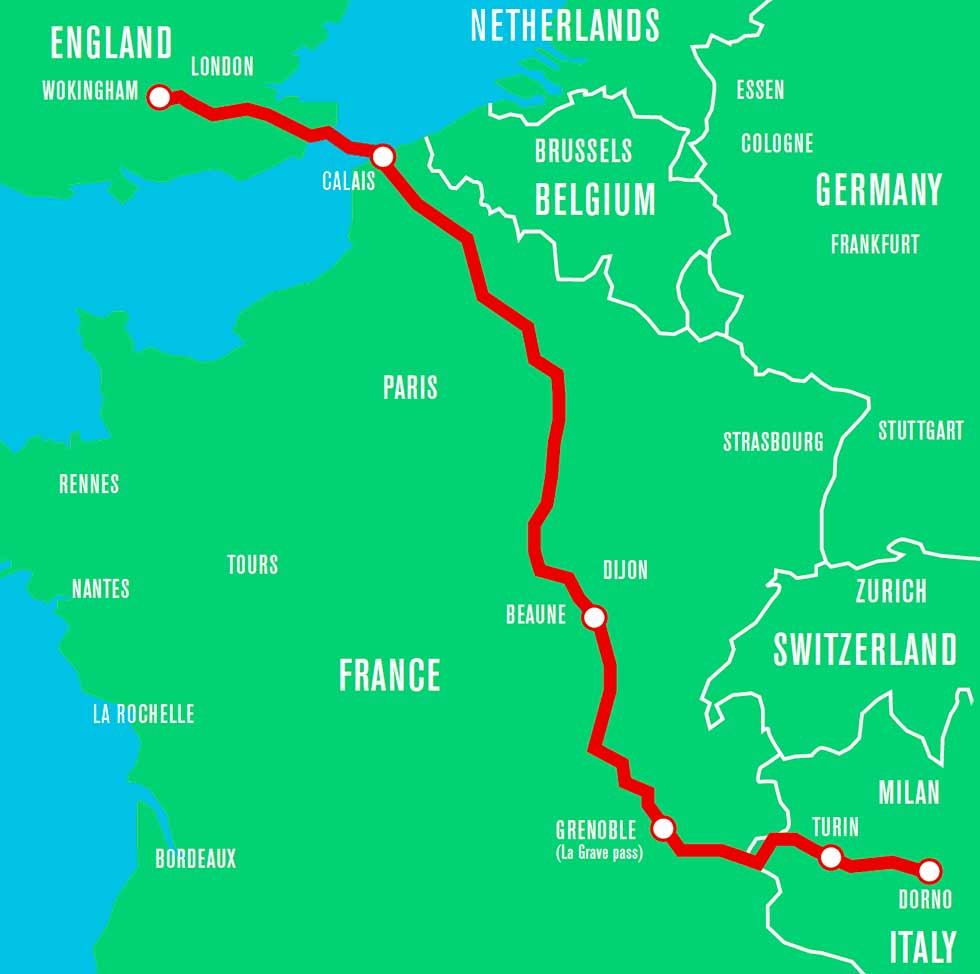
‘I look back over the past few days and the bond I have formed with the little car. I wouldn’t have wanted to drive anything else’
Post-graduate research the Graduate’ Spider 1967 The Graduate Alfa Romeo’s Duetto
Its appearance in 1967 movie The Graduate made Alfa Romeo’s Duetto a star. Mark Dixon tracks down the one surviving car from the film. Photography Evan Klein.
The car doesn’t fare well in the movie. It’s used and abused, and finally abandoned when it runs out of gas… but the little red Alfa Romeo Duetto is as well remembered today for its role in The Graduate as its human co-stars. Its fame may endure even longer; whenever Alfa Romeo launches a new sports car, it’s a safe bet that journalists will be searching YouTube for clips of Dustin Hoffman at the wheel of his 1966 Duetto.
Even if you haven’t seen the movie in a while, you’ll remember the plot. It centres on the doomed affair between disillusioned college graduate Benjamin Braddock (Dustin Hoffman) who’s seduced by an older married woman, Mrs Robinson (Anne Bancroft). Much to his surprise, Ben falls in love with Mrs Robinson’s daughter, Elaine (Katharine Ross); the bizarre love-triangle culminates in a dramatic final scene in which Ben gate-crashes Elaine’s wedding to her dull-but-eligible fiancé and… well, if you’ve forgotten, you need to watch the movie again. It’s well worth revisiting.
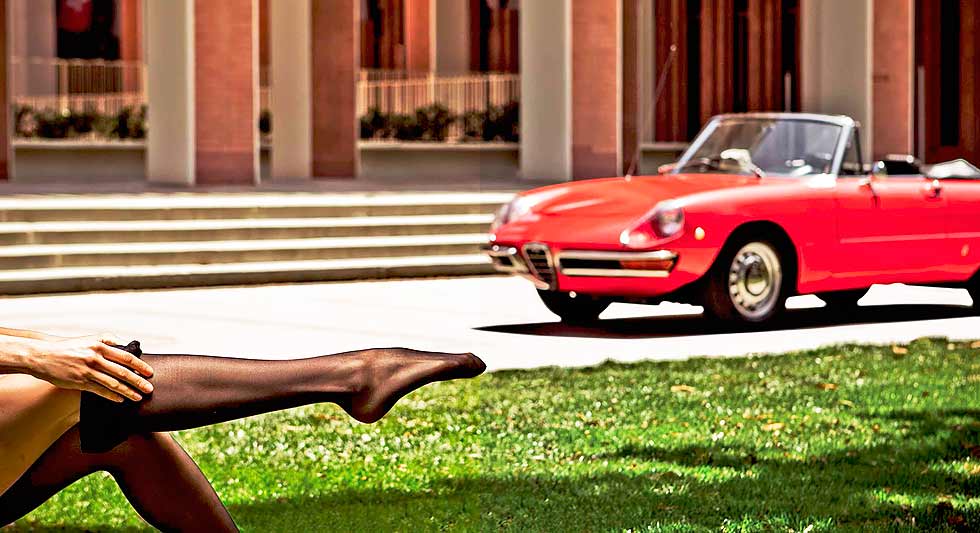
The red Alfa is Ben’s graduation present and, in its own way, symbolic of his disaffectation with material life. Glossy and gleaming when we first see it, the car has become grimy and neglected by the time Ben junks it at the side of the road in his mad rush to rescue Elaine. Ben certainly doesn’t give the Alfa any special treatment: in one memorable scene, during a date with Elaine, he swerves and runs it heavily onto a high kerb, causing sparks to fly.
That unscheduled bit of parking may be the reason why more than one Duetto was used in the movie. The underside of the car would definitely have been damaged, perhaps enough to render it undrivable. Certainly, footage of at least two Duettos – possibly three; no-one knows for sure – is cut together at various points. Movie anoraks have spotted that there are two different radios in the driving shots, and sometimes the car sports a radio aerial and sun visors, and sometimes it doesn’t.

The Graduate was released on 22 December 1967, and therefore timely product placement for the Duetto, which made its debut at Geneva in March 1966. Using the same underpinnings as its sister Giulia coupé and saloon, though on a shorter wheelbase, it was launched with the same 1570cc twin-cam engine and the same all-round disc brakes and five-speed gearbox.
Unlike certain British sports cars, the Duetto also had a hood that was a cinch to raise or lower – as Dustin Hoffman proves in the film, when he closes it one-handed during a getting-to- know-you conversation with Elaine at a drive-in. It was a thoroughly modern machine. Incidentally, while car enthusiasts still use the name Duetto, it had to be dropped soon after the car’s launch because an Italian chocolate manufacturer had already registered the word, which means ‘duet’ in Italian.

Officially, the car was known as the Alfa Romeo Spider 1600. That didn’t worry one Giodobaldo Trionfi of Palestro, Italy, who had suggested ‘Duetto’ in a competition run by Alfa Romeo to name the new car, and who won an early production example for his trouble.
Like its coupé and saloon siblings, the Duetto rapidly evolved. The 1570cc engine was superseded by Alfa’s 1750 unit in January 1968, and a 1300 Junior version became available in June that year. All these versions had Pininfarina’s ‘boat-tail’ styling, which was chopped back for 1970 to a more conventional shape with a vertical rear panel, the 1750 engine being displaced by a 1962cc unit.
In the 1980s the car was facelifted twice more, primarily to accommodate impactresistant bumpers; but, while these heavier, softer versions of Alfa Romeo’s once-delicate Spider have their followers, it’s the original boat-tails that are most sought-after today, not least for that subliminal association with a young Dustin Hoffman and his quest for self-awareness. Such was the enduring influence of the movie and its ‘Summer of Love’ vibes, Alfa Romeo even produced an entry-level ‘Graduate’ edition for North America during 1985-1990.
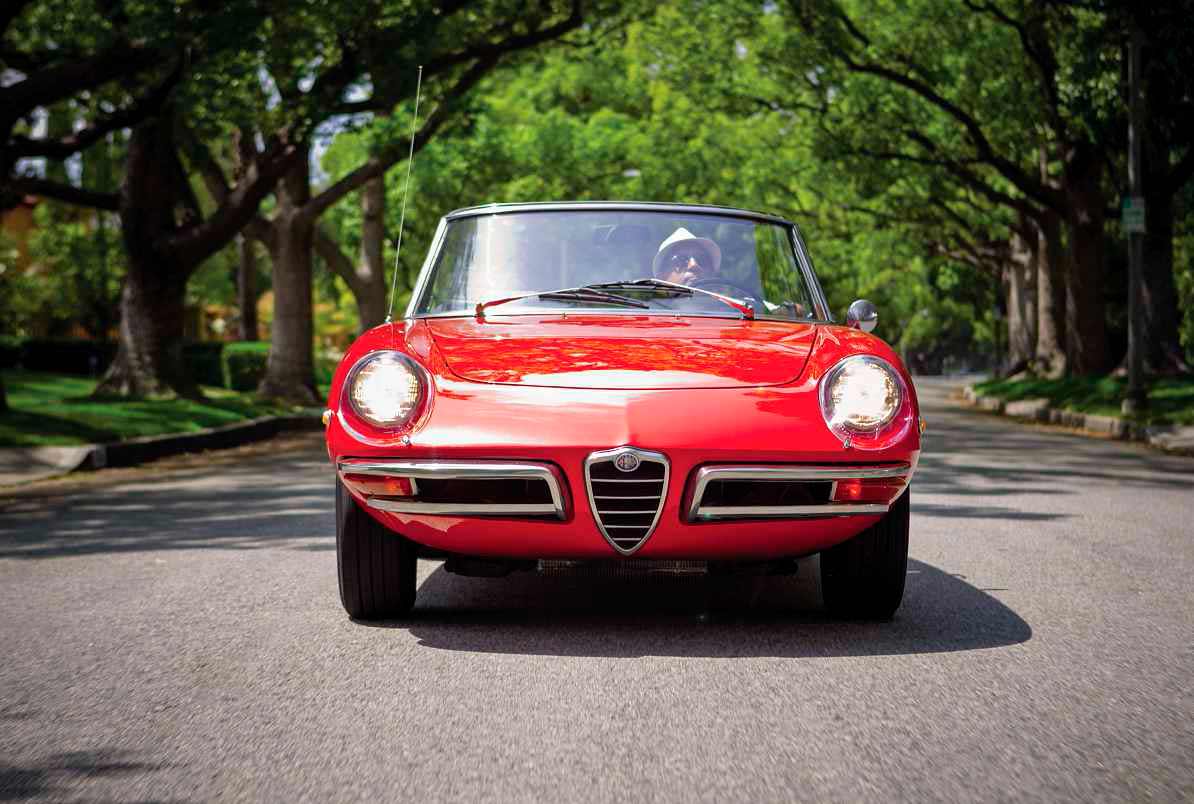
We should make it clear at this point that our feature car is not one from the movie. It’s actually a slightly later 1750 model, owned by LA-based optician Haig Chorbajian, who was persuaded by Octane photographer Evan Klein to revisit some of The Graduate’s locations for a nostalgic photoshoot. Seeing the red Alfa parked outside the church, United Methodist in La Verne – re-imagined as First Presbyterian in Santa Barbara for movie purposes – at which Ben hammers on the window in a desperate attempt to halt Elaine’s marriage ceremony, feels rather spooky.
Curiously, however, while The Graduate has been endlessly referenced down the decades in articles about Alfa Spiders, very little has appeared either in print or online about the actual cars used in the movie. That’s largely because no records were kept of the cars during the filming itself; they were tools for a job, and no more. Search the net, and you’ll find it repeatedly stated that Alfa’s then-new Spider 1600 was chosen for the movie because Dustin Hoffman was the nephew of US Alfa importer Max Hoffman. On the face of it, this sounds plausible: Dustin and Max were both living in New York at the time The Graduate was being cast, and Hoffman is surely an unusual name for an American. Or is it?
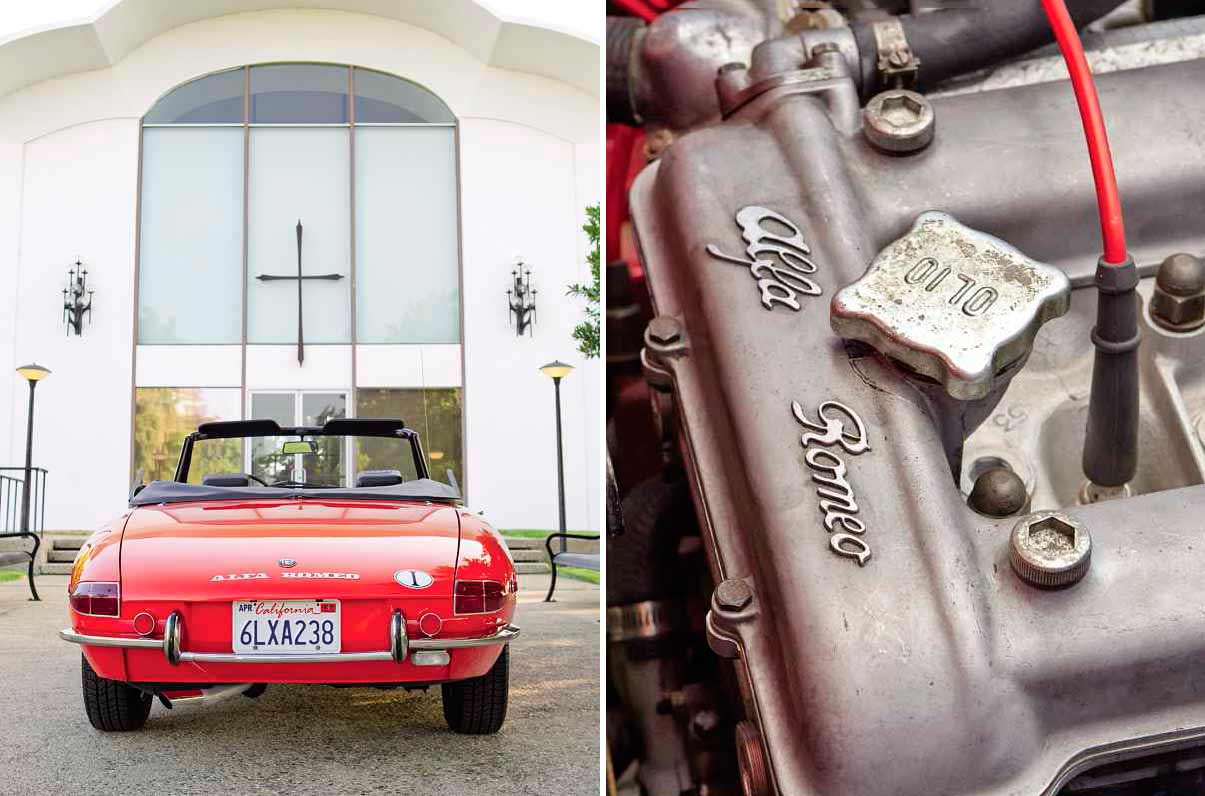
In fact, Hoffman turns out to be a relatively common surname in the USA, particularly in New York, a result of German and Jewish émigrés arriving in the 19th Century. Suddenly, this theory starts to look a little too convenient – so we contacted Octane columnist Jay Leno to see if he knew the truth. ‘I’ve no idea,’ said Jay. ‘Do you want me to call Dustin and find out?’ As always, Jay was as good as his word. A couple of days later he phoned back: ‘Dustin says there is absolutely, categorically, no connection. He’s even had a genealogy test done to check!’
So there you have it, straight from the horse’s mouth. As for whether two or three Duettos were used for filming: well, that’s less clear-cut. However, it seems pretty definite that one of them was turned into a race car soon after shooting wrapped. And we’ve tracked it down. Karen Macgowan, who lives in Colorado and ran an Alfa workshop for many years, has owned her racing Duetto since 1969. It reputedly starred in The Graduate and she told Octane how she came to acquire it.
‘In 1967 I was racing a 1300 Veloce but I wanted something faster, and in late ’68, after the SCCA National Championship was over, two Alfa race cars came up for sale. The asking price for each was something like $15,000 and I thought, well, that’s not happening! Then, in June of ’69, a friend called me up and said “Those cars are for sale at $3000 apiece”.
‘That was still a fair bit of money in 1969, but I called up Lee Midgley, who was the owner/driver of the Alfa that placed second in the 1968 US Champions race at Riverside, and sent him a deposit for his car. He ran an Alfa dealership called Sports Car Service in Riverside, California, with fellow racer Bob Griffith, and Bob’s was the other car for sale. ‘I collected my car on 13 June. It was a full race car then, still with a 1600cc engine but with GTA gearbox and sliding-block GTA rear suspension. I believe the reason it was painted orange was because the Alfa parts department sponsored the car in some way, and their parts came in orange-and-white boxes. At that time, I didn’t have a clue about any connection with the movie.’
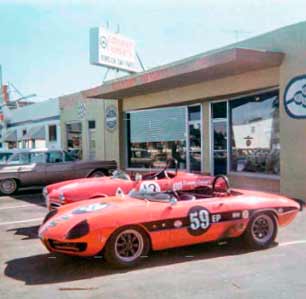
Karen competed with the car from 1969 to ’1972, when her job took her to Nashville and then, in the mid-70s, to Colorado. It was at an Alfa Owners Club of Colorado meet that she first heard that she owned a movie car.
‘The club was meeting at the Alfa showroom in Denver, and afterwards I was having a few beers with one of the sales guys and he said, “You do realise your car is the one from The Graduate?” So I did some checking, and Lee Midgley – who, unfortunately, passed some years ago – confirmed that his was the movie car. But even then, just ten years after the movie had been made, it wasn’t easy getting any information. Nobody kept any records.
‘The Alfa did come with a manufacturer’s statement of origin, which stated that the car had never been registered in the US [a fake Californian plate, OUP 367, was used in the movie]. So I think that maybe Alfa Romeo owned it during the filming, and then worked out a deal with Lee Midgley, who was an Alfa dealer but who had been racing a Triumph TR3 in ’1967. A second race car was built-up for Bob Griffith to drive, but that wasn’t a movie car and it has since disappeared. To be honest, while it was kind of cool to think mine had been used in The Graduate, I wasn’t too bothered. It was just my race car.’
Nevertheless, Karen was interested enough to speak with some of her Alfa contacts on the West Coast, where her father had been a founder member of the owners club in California, and the consensus was that three Duettos had been used in the movie. One was written off and Karen has one. As for the putative third car? No-one knows, and it seems unlikely now that anyone ever will.
The odds get longer with every passing year. Acting on a tip-off from photographer Evan Klein, Octane contacted the listed address for a certain Joel Schiller, who was assistant to the production designer on The Graduate. Unfortunately, Mr Schiller passed away on 17 January this year, and with him perhaps went the last opportunity to learn the truth about The Graduate Alfas. Unless anyone out there knows better?

The Graduate is being re-released this summer by StudioCanal on DVD, Blu-Ray and EST to mark its 50th anniversary, specially restored in 4K Ultra High Definition from the original 35mm footage. It will also have a two-week run at the British Film Institute on London’s South Bank from 23 June.
‘The Graduate was timely product placement for the Duetto, which made its debut at Geneva in March 1966’
Below and facing page Dustin Hoffman abuses his Alfa in The Graduate; half-a-century on, another Spider poses outside the University of Southern California, Los Angeles – standing in for Berkeley, near San Francisco, in the movie.
‘Very little has appeared in print or online about the cars used in the movie, because no records were kept’
Above and facing page Los Angeles optician Haig Chorbajian exercises his 1750 Spider before halting outside the very church (top left) from which Ben rescues Elaine in the movie.
‘One of the Alfas from the movie was turned into a race car soon after shooting wrapped – and we’ve tracked it down’
Above Hard to imagine, but this is one of the original Duettos from The Graduate, transformed into a race car and snapped with Karen Macgowan’s 1300 Spider Veloce in California in 1969.





